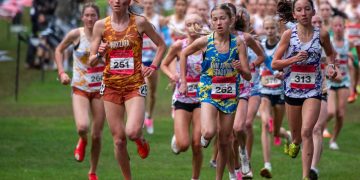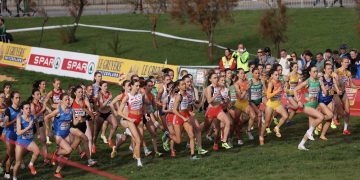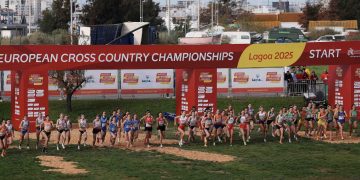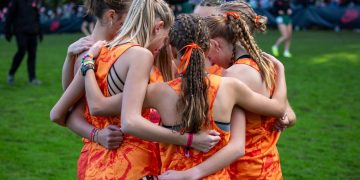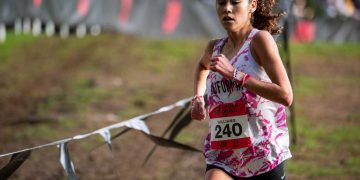On October 8, 2017, Galen Rupp won his first big city marathon. And Mr. Rupp picked the right race to take his second marathon win. In his fourth marathon, Galen used his track speed to separate himself from the likes of two time World Champion, Abel Kirui, at 35 kilometers. Rupp used a 14:25 for ther 5 kilometers from 35 kilometers to 40 kilometers.
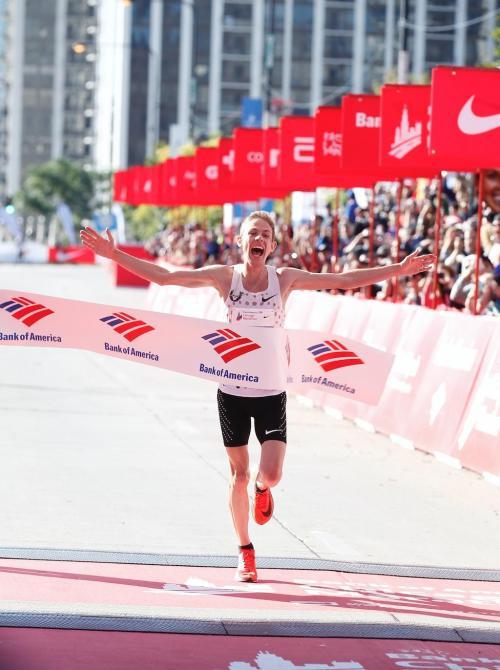 Galen Rupp, photo by Chicago Marathon
Galen Rupp, photo by Chicago Marathon
But, Galen Rupp was not done. Rupp ran a 2:38 for the penultimate kilometer, from 40 to 41 kilometers, and finished the 42.2 kilometers in PB of 2:09:20. Galen Rupp’s win was historic in Chicago. Mr. Rupp was first American to win since 2002 and the win of Khalid Khannouchi. Galen Rupp was the first American born since 1982 and one Michigan gentleman, Greg Meyer.
The 2018 race should be completely different. First, pacemakers are back to Chicago. Second, Mo Farah is racing his first marathon outside of London, and finally, the race could have a cold, windy rain.
Neither Galen Rupp nor Mo Farah would be here if they could not race well.
How will Galen Rupp do?
I was trying to consider how to explain the toughness of Galen Rupp. I am going to start with a story from November 2003. It is the Sunday before the American holiday of Thanksgiving, Nike holds a unique event on their Beaverton campus. It is called the Nike Border Clash. The races feature the top 40 high school boys and girls from Oregon and Washington over a 4000 meter course around the beautiful Nike campus. The Border Clash was the brain child of Johnny Truex and Josh Rowe, two Nike employees (Rowe has since left Nike), and it was for bragging rights on which state has the best high school cross country runners. I have missed two years between 1998 and 2017. It is one of my favorite events.
In the 2003 Nike Border Clash, Galen Rupp, then, a high school junior, won the cool, damp 4,000 meter race. By this time, Galen Rupp was also a state champion, and he won the Border Clash in style. Rupp, as a high school junior, already had a following. A nice win, for most athletes, that would have been it for the day. Not for Galen Rupp. While most of the fields of 80 were speaking to family and friends, Galen was doing 12 times 300 meters under the watchful eye of his high school coach, Alberto Salazar. Galen Rupp was beat from his race, but Rupp wanted to know what it was like to be a world class runner, happy to oblige, Albertor Salazar put him through the paces. Early lessons learned are important.
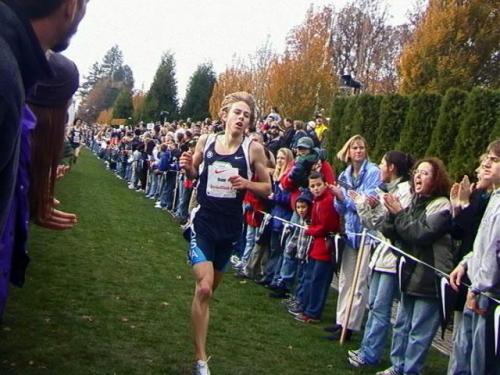 Galen Rupp wins Nike Border Clash 2003, photo from Nike Border Clash/Runnerspace.com
Galen Rupp wins Nike Border Clash 2003, photo from Nike Border Clash/Runnerspace.com
In February 2011, Galen Rupp and Mo Farah began training together. It was announced in February 2011, as Farah moved to Portland, to train under the eye of Albertro Salazar, in the Nike Oregon Distance Project. Alberto Salazar spoke with this writer, in the spring of 2012, on how well Galen and Mo trained together. This writer once asked Galen Rupp about training and racing with Mo Farah. Galen smiled. He told me about a story, when Mo had lost his passport. Galen was worried for him, and Mo just said, ” Don’t worry, mate. Let’s go get our run in, and we will figure it out later.” Galen said, ” Mo helps me relax.”
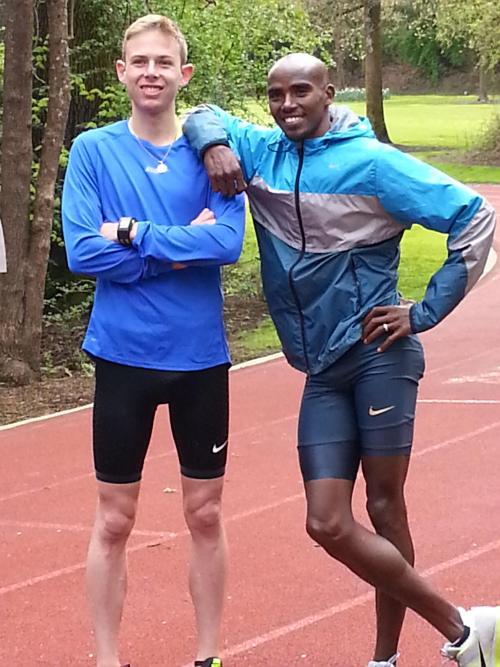 Galen Rupp, Mo Farah, April 2013, photo by The Shoe Addicts
Galen Rupp, Mo Farah, April 2013, photo by The Shoe Addicts
In April 2013, the IAAF sponsored a group of media to visit Aries Merritt, Ashton Eaton and Mo Farah and Galen Rupp as part of the Day in the Life program. It was brilliant. We saw Mo Farah, Galen Rupp, Matt Centrowitz, Cam Levins do a workout. They began on the soccer pitch, with 3 x mile, 1200, 800, 400.
The first two sets were impressive, with repeats in 4:28-4:30 for mile, 1200 in 3:16-3:20 and 800 meters in 2 minutes. The final set was done on the Micheal Johnson Track. The mile was done in 4:06, the 1200 meters in 3:04, and the 800 meters in 1:55. Mo wanted to fly over the last 400 meters, and Alberto Salazar noted that nothing faster than 52 seconds! Mo ran 52, Galen ran 54.
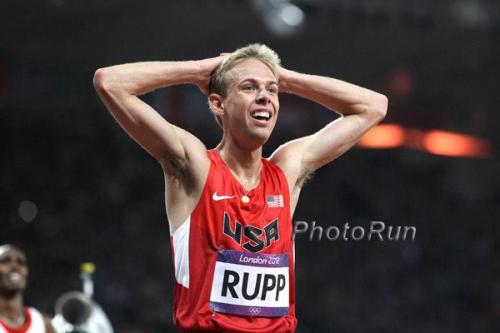 Galen Rupp, London 2012, has just become a silver medalist, photo by Photorun.net
Galen Rupp, London 2012, has just become a silver medalist, photo by Photorun.net
By 2013, Galen Rupp had won his first Olympic medal, the silver in the 10,000 meters, in London 2012. His training partner, Mo Farah, had completed the 5000m/10,000m double in London. They were training for Moscow 2013 when the IAAF media group visited. Truth be told, I did not expect Galen to win his first Olympic medal until 2016. The 10,000m, 5,000m are two the toughest events in all of global sports. Galen Rupp, by 2012, had been training hard for a decade. He knew how to run hard when tired, and he has confidence in his coach and also his fitness.
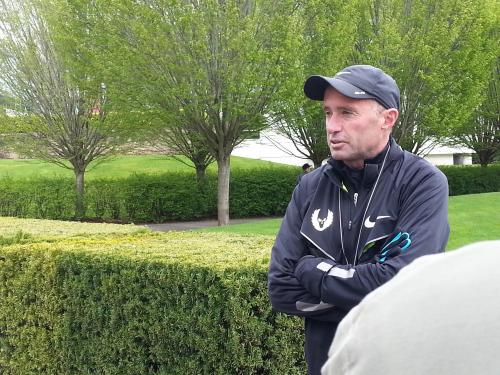 Alberto Salazar, April 2013, photo by The Shoe Addicts
Alberto Salazar, April 2013, photo by The Shoe Addicts
Galen Rupp won his first marathon, the 2016 U.S. Olympic Trials, held on February 13, 2016, battling Meb Keflezighi, 2004 Olympic silver medalist and 4th place in London, taking the win in 2:11:13. The race got a bit physical, as races sometimes do. The media was less than supportive of Galen Rupp, and Galen was, well, ill at ease. A private person, Galen wants to run, be with his family and quite frankly, let his feet do his talking. I thought that the treatment of Galen in LA was quite poor.
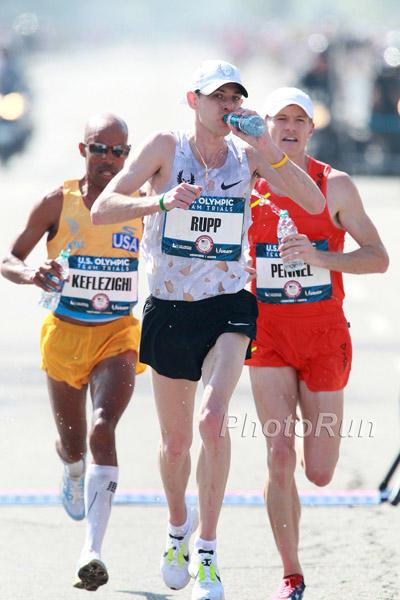 Meb Keflezighi, Galen Rupp, Tyler Pennel, photo by PhotoRun.net
Meb Keflezighi, Galen Rupp, Tyler Pennel, photo by PhotoRun.net
The last two miles in LA were hot and challenging. Galen Rupp did not look like a happy camper. Obviously, the heat, direct sun and pace all challenged Galen Rupp, but the Oregonian is one tough hombre. The field in Los Angeles was decimated by the heat, humidity and deadly direct sunlight, which beat down on the marathoners for the two plus hours, as dreams were both dashed and achieved.
For Galen Rupp, the Olympic marathon may have been a bit easier. Let me correct myself. There is no such animal as an easy marathon. It came down, on a rainy day, to battling the elements, plus Eliud Kipchoge and Feyisa Lelisa. Olympic marathons are always battles of attrition. Kipchoge, Lelisa and Rupp were three of the best in the field. Galen took the bronze, setting another PB, in 2:10:05. A second Olympic medal, this time, a bronze, for the young man from Central Catholic High School, in Portland, Oregon.
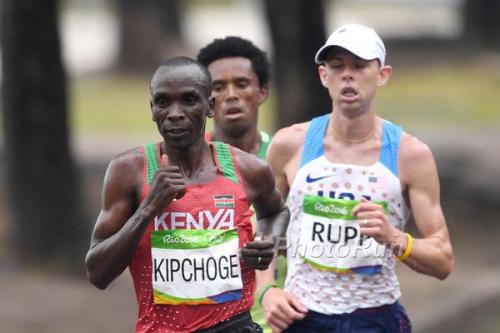 In the heat of battle, Eliud Kipchoge, Feyisa Lelisa, Galen Rupp, photo by Photorun.net
In the heat of battle, Eliud Kipchoge, Feyisa Lelisa, Galen Rupp, photo by Photorun.net
In his third marathon, Galen took second in Boston, having battled an injury in the four weeks prior to the race. Another PB, Galen Rupp look composed througout the race. He battled Geoffrey Kirui through 23 miles where Kirui went for the win, taking Boston in 2:09:23, with Galen in 2:09:58, another PB.
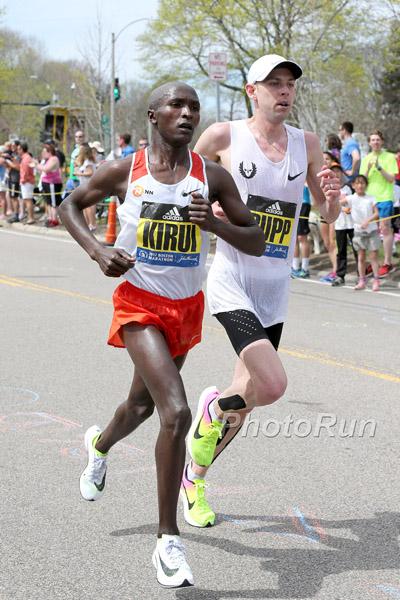 Geoffrey Kirui, Galen Rupp, Boston 2017, photo by PhotoRun.net
Geoffrey Kirui, Galen Rupp, Boston 2017, photo by PhotoRun.net
His fourth marathon was the win in Chicago last year in a nice PB of 2:09:20. The race was slow up in the first half, and Galen came back flying to the finish.
 Galen Rupp, Boston 2018, photo by PhotoRun.net
Galen Rupp, Boston 2018, photo by PhotoRun.net
Marathons are always about lessons. Galen’s fifth race was a DNF, having dealth with mother Nature in Boston 2018. Three weeks later, Galen regrouped, and won the VW Prague Marathon, in 2:06:13, a strong PB. In coming back from the Boston DNF, Galen showed what he is made of: champion material.
And now, we have Galen Rupp, less than 36 hours before Chicago, and his battle with Mo Farah. Mo Farah continues to learn over the marathon distance, but has a wicked kick. Galen Rupp has to know Mo Farah well. Their competitive record is something like 21-1. And Galen admits that win was at the New Balance Indoor GP, where Mo fell down about a 200 meters into the indoor mile race.
This race, the 2018 Bank of America Chicago Marathon, could be fantastic sports television. Depending on how bad the weather is, the pace making could be irrelevant. Galen Rupp and Mo Farah will probably break the field, and then, decide the race between themselves.
This will be Galen Rupp’s most taxing race.
He is ready for it.
And the 2018 Bank of America Chicago Marrathon should be a wonderful race for the marathon fan.
Want bonus content on athletics? Support the sport of athletics! Support RunBlogRun as we cover the sport of athletics nearly 24/7, and get bonus content, please go to: https://www.patreon.com/
Author
-

Larry Eder has had a 52-year involvement in the sport of athletics. Larry has experienced the sport as an athlete, coach, magazine publisher, and now, journalist and blogger. His first article, on Don Bowden, America's first sub-4 minute miler, was published in RW in 1983. Larry has published several magazines on athletics, from American Athletics to the U.S. version of Spikes magazine. He currently manages the content and marketing development of the RunningNetwork, The Shoe Addicts, and RunBlogRun. Of RunBlogRun, his daily pilgrimage with the sport, Larry says: "I have to admit, I love traveling to far away meets, writing about the sport I love, and the athletes I respect, for my readers at runblogrun.com, the most of anything I have ever done, except, maybe running itself." Also does some updates for BBC Sports at key events, which he truly enjoys.
Theme song: Greg Allman, " I'm no Angel."
View all posts


